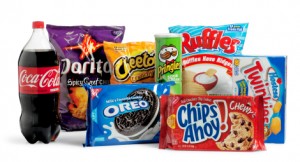Grocery store navigation 101— The path you follow in the grocery store can help you eat right, avoid unwanted weight gain, prevent and reverse certain health complications as well as increase your overall well-being. Now, envision the entire grocery store—produce section, meats, poultry, dairy, chips, cookies, crackers, beverages, grains/breads, fish and seafood etc.
Now, think of the path you usually take through the grocery store as you check off ingredients and foods from your list as you reach for them and place them in your cart. Are you spending most of that time in the middle aisles? Chances are, the unhealthier foods on your grocery list are in these middle aisles. And, if you find yourself here often, you might be reaching for highly processed foods. These processed foods are usually high-calorie packaged snack foods. They have been altered from their natural state through the addition of sugars, sodium, refined white flour (opposed to whole grains) and unhealthy saturated and trans fats to increase convenience and shelf life. The ingredients used to prolong shelf life, unfortunately, can and most often times have the opposite effects on our health.
Processed foods are composed of simple sugars and unhealthy fats that cause rapid spikes in blood sugar and insulin levels, which can promote weight gain, blood sugar irregularities and cholesterol imbalances. In addition, saturated- and trans-fats raise the “bad” LDL-cholesterol levels while lowering the “good” HDL-cholesterol levels. Highly processed foods have been linked to many chronic health conditions such as obesity, diabetes and cardiovascular disease.
Avoid highly processed foods: The perimeter shopping method—If the middle aisles are filled with highly processed foods, where should you spend most of your time gathering groceries? The answer to this question is: along the perimeter. Foods closest to their natural forms are usually located along the outside areas of the grocery store. These foods include: dairy, bread/whole grains, meats/seafood, and fresh produce.
Shopping along the perimeter of the store is your ticket to better health through these nutrient-rich foods. This is also the best way to ensure that you are avoiding those highly processed foods with added sugars and artificial ingredients found within the middle aisles. These “perimeter” foods are in their most natural form, which means they haven’t been stripped of their healthy nutrients. This is why most of these foods are highly perishable. They haven’t been tampered with, like processed foods, in order to achieve higher shelf life. They are fresh and contain large amounts of vitamins, minerals, proteins, whole grains and healthy fats.
Time Saved
 Don’t get “processed.” Stay simple—sticking to the outer edges of the grocery store ensure you’ll be getting the biggest bang for your buck. And, this doesn’t just apply to the money in your pocket. This means your health! “Eat the colors of the rainbow”—Consuming a variety of fruits and vegetables, daily, provides you with many vitamins, minerals and other natural substances that help protect you from chronic diseases. And, eating fruits and vegetables of different colors gives your body a wide range of valuable nutrients, such as: fiber, folate, potassium, and many antioxidants (vitamins A and C). Increased consumption of fruits and vegetables can lower cholesterol levels, boost immune function, help you to maintain a healthy weight and aid in the reversal of many chronic health conditions. The addition of “simple”, natural foods, especially increased consumption of fruits and vegetables, in place of unhealthy, processed foods can help someone to get off of prescription medications and increase health, energy levels, performance and overall well-being.
Don’t get “processed.” Stay simple—sticking to the outer edges of the grocery store ensure you’ll be getting the biggest bang for your buck. And, this doesn’t just apply to the money in your pocket. This means your health! “Eat the colors of the rainbow”—Consuming a variety of fruits and vegetables, daily, provides you with many vitamins, minerals and other natural substances that help protect you from chronic diseases. And, eating fruits and vegetables of different colors gives your body a wide range of valuable nutrients, such as: fiber, folate, potassium, and many antioxidants (vitamins A and C). Increased consumption of fruits and vegetables can lower cholesterol levels, boost immune function, help you to maintain a healthy weight and aid in the reversal of many chronic health conditions. The addition of “simple”, natural foods, especially increased consumption of fruits and vegetables, in place of unhealthy, processed foods can help someone to get off of prescription medications and increase health, energy levels, performance and overall well-being.
Portion Control
Fruits and Vegetables—The amount of fruits and vegetables you need to eat daily depends on your age, sex and level of physical activity. A rough estimate is about 2-3 cups of vegetables per day and 1 ½ to 2 cups of fruit per day. The Academy of Nutrition and Dietetics recommends that half your plate be filled with fruits and vegetables, about one fourth with lean meat, poultry or fish, and one-fourth with grains. To round out your meal, add fat-free or low-fat milk, yogurt or cheese.
Every thing in moderation—Although regular consumption of processed foods can be harmful to our health, it depends on the degree (how much and how often) to which you choose to eat these foods. There’s nothing wrong with indulging in your favorite treat or snack. Use the “80/20 Rule”—if you spend 80% of your time adhering closely to a healthy lifestyle, your health should be able to withstand whatever you do during the remaining 20% of the time.
You can also apply the 80/20 rule to your grocery store shopping cart—80% of the foods you choose should be in their most natural forms (lean meats, whole grains, fruits, vegetables) while the remaining 20% can be those tasty treats or condiments/ingredients that add extra flavor to your meal. The “80/20 Rule” works beautifully to incorporate a well-balanced diet into your life.
Don’t Get Ripped Off
“Work smarter, not harder”—Many headlines on food packages make claims and statements, such as: “low-fat”, “with whole grain”, “gluten-free”, however, they may be completely void of any real nutritional value. This is where we can be fooled if we don’t have a sharp eye to spot these red flags! It’s all about nutritional literacy. Yes, a food may be made with whole grain, but 95% of it is processed. This also gives rise to the health halo effect: when the perception of positive qualities in one part of an object/product gives rise and influences an overall positive perception for the entire object/product. For example, a food labeled as ”low fat” can cause one to believe that same food is low calorie. However, many foods that are low in fat make up for taste through added sugar. This common mistake ultimately results in a high-calorie food choice.
Don’t get robbed of your money, time and more importantly, your health. Knowing how to eat and what to eat can give you a new lease on life, the natural way. Choosing the right foods will make every second of your workout count, decrease visits to the doctor and improve performance. Whether you’re a seasoned athlete or someone simply trying to improve your overall quality of life, knowing how to choose the right foods for optimum health is vital to living a truly fulfilling life.
To Sum it All Up:
Processed Food Facts:
- They have been altered from their natural state through the addition of sugars, sodium, refined white flour, and unhealthy saturated and trans fats.
- Cause rapid spikes in blood sugar and insulin levels sometimes resulting in a “sugar (glucose) crash”, also known as reactive hypoglycemia, with symptoms of fatigue, lethargy, and irritation.
- These foods are usually high-calorie packaged snack foods
- These foods are composed of simple sugars and unhealthy (saturated and trans) fats.
Health Concerns Linked with Processed Foods:
- Cause rapid spikes in blood sugar and insulin levels, which can promote weight gain, blood sugar irregularities and cholesterol imbalances.
- Saturated- and trans-fats raise the “bad” LDL-cholesterol levels while lowering the “good” HDL-cholesterol levels.
- Highly processed foods have been linked to many chronic health conditions such as obesity, diabetes and cardiovascular disease.
Fruits and vegetables health benefits: “Eat the colors of the rainbow”
- Consuming a variety of fruits and vegetables, daily, provides you with many vitamins, minerals and other natural substances that help protect you from chronic diseases.
- Fruits and vegetables of different colors give your body a wide range of valuable nutrients, such as: fiber, folate, potassium, and many antioxidants (vitamins A and C).
- Increasing the consumption of fruits and vegetables can lower cholesterol levels, boost immune function, help you to maintain a healthy weight and aid in the reversal of many chronic health conditions.
- Substituting fruits and vegetables in place of unhealthy, processed foods can help someone to get off of prescription medications.
- Increase health, energy levels, performance and overall well-being
How to Save Time and Shop Smart:
- Shop the perimeter.
- Avoid middle aisles.
- Stick to foods that are closest to their most natural form.
- Consume a variety of fruits and vegetables.
- Do not make food choices based on packaging and marketing statements.
- Make food choices based on ingredients.
- Avoid the health halo effect.
- Use the 80/20 rule.
References
Academy of Nutrition and Dietetics. (2012). Retrieved May 19, 2012, from http://www.eatright.org/
Nutrient Data Laboratory. Search the USDA National Nutrient Database for Standard Reference. Retrieved May 19, 2012, from www.nal.usda.gov/fnic/foodcomp/search
Sports, Cardiovascular, and Wellness Nutrition. (2012). Retrieved May 20, 2012, from http://www.scandpg.org/
About Brooke R. Kugler, M.S., CISSN
Brooke has devoted her life to research and the practical application of dietetics and sports nutrition. She has been involved in competitive sports throughout her entire life, including 14 years of professional figure skating. But, it wasn’t until she began competing in figure and fitness competitions where she realized her true passion for the field of sports nutrition, and that was the spark that set the stage for the rest of her life! She believes that there’s nothing better than helping someone achieve a successful and positive physical and mental—full-body–transformation. She will soon be a registered dietitian and plans on focusing her efforts on bridging the gap between sports nutrition research and sport nutrition practice.




